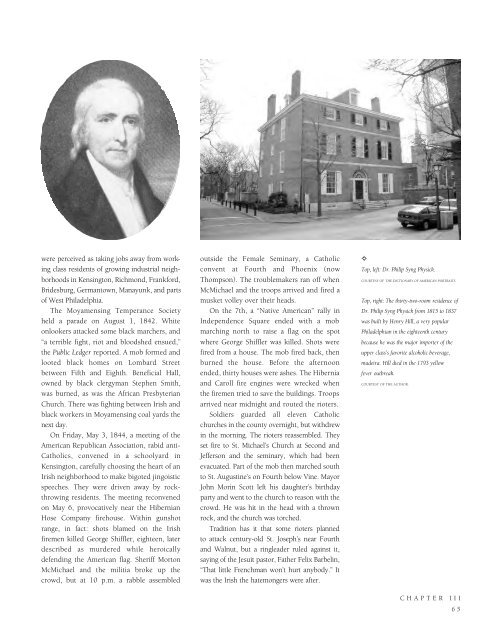Historic Philadelphia
An illustrated history of the city of Philadelphia, paired with the histories of companies, families and organizations that make the region great.
An illustrated history of the city of Philadelphia, paired with the histories of companies, families and organizations that make the region great.
Create successful ePaper yourself
Turn your PDF publications into a flip-book with our unique Google optimized e-Paper software.
were perceived as taking jobs away from working<br />
class residents of growing industrial neighborhoods<br />
in Kensington, Richmond, Frankford,<br />
Bridesburg, Germantown, Manayunk, and parts<br />
of West <strong>Philadelphia</strong>.<br />
The Moyamensing Temperance Society<br />
held a parade on August 1, 1842. White<br />
onlookers attacked some black marchers, and<br />
“a terrible fight, riot and bloodshed ensued,”<br />
the Public Ledger reported. A mob formed and<br />
looted black homes on Lombard Street<br />
between Fifth and Eighth. Beneficial Hall,<br />
owned by black clergyman Stephen Smith,<br />
was burned, as was the African Presbyterian<br />
Church. There was fighting between Irish and<br />
black workers in Moyamensing coal yards the<br />
next day.<br />
On Friday, May 3, 1844, a meeting of the<br />
American Republican Association, rabid anti-<br />
Catholics, convened in a schoolyard in<br />
Kensington, carefully choosing the heart of an<br />
Irish neighborhood to make bigoted jingoistic<br />
speeches. They were driven away by rockthrowing<br />
residents. The meeting reconvened<br />
on May 6, provocatively near the Hibernian<br />
Hose Company firehouse. Within gunshot<br />
range, in fact: shots blamed on the Irish<br />
firemen killed George Shiffler, eighteen, later<br />
described as murdered while heroically<br />
defending the American flag. Sheriff Morton<br />
McMichael and the militia broke up the<br />
crowd, but at 10 p.m. a rabble assembled<br />
outside the Female Seminary, a Catholic<br />
convent at Fourth and Phoenix (now<br />
Thompson). The troublemakers ran off when<br />
McMichael and the troops arrived and fired a<br />
musket volley over their heads.<br />
On the 7th, a “Native American” rally in<br />
Independence Square ended with a mob<br />
marching north to raise a flag on the spot<br />
where George Shiffler was killed. Shots were<br />
fired from a house. The mob fired back, then<br />
burned the house. Before the afternoon<br />
ended, thirty houses were ashes. The Hibernia<br />
and Caroll fire engines were wrecked when<br />
the firemen tried to save the buildings. Troops<br />
arrived near midnight and routed the rioters.<br />
Soldiers guarded all eleven Catholic<br />
churches in the county overnight, but withdrew<br />
in the morning. The rioters reassembled. They<br />
set fire to St. Michael’s Church at Second and<br />
Jefferson and the seminary, which had been<br />
evacuated. Part of the mob then marched south<br />
to St. Augustine’s on Fourth below Vine. Mayor<br />
John Morin Scott left his daughter’s birthday<br />
party and went to the church to reason with the<br />
crowd. He was hit in the head with a thrown<br />
rock, and the church was torched.<br />
Tradition has it that some rioters planned<br />
to attack century-old St. Joseph’s near Fourth<br />
and Walnut, but a ringleader ruled against it,<br />
saying of the Jesuit pastor, Father Felix Barbelin,<br />
“That little Frenchman won’t hurt anybody.” It<br />
was the Irish the hatemongers were after.<br />
✧<br />
Top, left: Dr. Philip Syng Physick.<br />
COURTESY OF THE DICTIONARY OF AMERICAN PORTRAITS.<br />
Top, right: The thirty-two-room residence of<br />
Dr. Philip Syng Physick from 1815 to 1837<br />
was built by Henry Hill, a very popular<br />
<strong>Philadelphia</strong>n in the eighteenth century<br />
because he was the major importer of the<br />
upper class’s favorite alcoholic beverage,<br />
madeira. Hill died in the 1793 yellow<br />
fever outbreak.<br />
COURTESY OF THE AUTHOR.<br />
CHAPTER III<br />
65
















